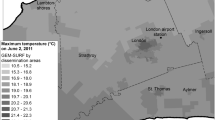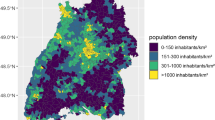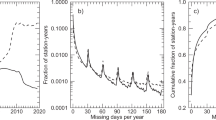Abstract
Local trends in ozone concentration may differ by meteorological conditions. Furthermore, the trends occurring at the extremes of the Ozone distribution are often not reported even though these may be very different than the trend observed at the mean or median and they may be more relevant to health outcomes. Classify days of observation over a 16-year period into broad categories that capture salient daily local weather characteristics. Determine the rate of change in mean and median O3 concentrations within these different categories to assess how concentration trends are impacted by daily weather. Further examine if trends vary for observations in the extremes of the O3 distribution. We used k-means clustering to categorize days of observation based on the maximum daily temperature, standard deviation of daily temperature, mean daily ground level wind speed, mean daily water vapor pressure and mean daily sea-level barometric pressure. The five cluster solution was determined to be the appropriate one based on cluster diagnostics and cluster interpretability. Trends in cluster frequency and pollution trends within clusters were modeled using Poisson regression with penalized splines as well as quantile regression. There were five characteristic groupings identified. The frequency of days with large standard deviations in hourly temperature decreased over the observation period, whereas the frequency of warmer days with smaller deviations in temperature increased. O3 trends were significantly different within the different weather groupings. Furthermore, the rate of O3 change for the 95th percentile and 5th percentile was significantly different than the rate of change of the median for several of the weather categories.We found that O3 trends vary between different characteristic local weather patterns. O3 trends were significantly different between the different weather groupings suggesting an important interaction between changes in prevailing weather conditions and O3 concentration.
This is a preview of subscription content, access via your institution
Access options
Subscribe to this journal
Receive 6 print issues and online access
$259.00 per year
only $43.17 per issue
Buy this article
- Purchase on Springer Link
- Instant access to full article PDF
Prices may be subject to local taxes which are calculated during checkout









Similar content being viewed by others
References
Kelly VR, Lovett GM, Weathers KC, Likens GE . Trends in atmospheric concentration and deposition compared to regional and local pollutant emissions at a rural site in southeastern New York, USA. Atmos Environ 2002; 36: 1569–1575.
Fann N, Risley D . The public health context for PM2. 5 and ozone air quality trends. Air Quality. Atmos Health 2013; 6: 1–11.
Parrish DD, Singh HB, Molina L, Madronich S . Air quality progress in North American megacities: a review. Atmos Environ 2011; 45: 7015–7025.
Lin CC, Jacob DJ, Fiore AM . Trends in exceedances of the ozone air quality standard in the continental United States, 1980–1998. Atmos Environ 2001; 35: 3217–3228.
Cooper O, Parrish D, Stohl A, Trainer M, Nédélec P, Thouret V et al. Increasing springtime ozone mixing ratios in the free troposphere over western North America. Nature 2010; 463: 344–348.
Bojkov RD, Bishop L, Fioletov VE . Total ozone trends from quality‐controlled ground‐based data (1964–1994). J Geophys Res Atmos 1995; 100: 25867–25876.
Logan J, Staehelin J, Megretskaia I, Cammas J, Thouret V, Claude H et al. Changes in ozone over Europe: Analysis of ozone measurements from sondes, regular aircraft (MOZAIC) and alpine surface sites. J Geophys Res Atmos 2012; 117: 1–23.
Chan E, Vet R . Baseline levels and trends of ground level ozone in Canada and the United States. Atmos Chem Phys 2010; 10: 8629–8647.
Jaffe D, Ray J . Increase in surface ozone at rural sites in the western US. Atmos Environ 2007; 41: 5452–5463.
Bloomer BJ, Vinnikov KY, Dickerson RR . Changes in seasonal and diurnal cycles of ozone and temperature in the eastern US. Atmos Environ 2010; 44: 2543–2551.
Logan JA . Tropospheric ozone: seasonal behavior, trends, and anthropogenic influence. J Geophys Res Atmos 1985; 90: 10463–10482.
Schichtel BA, Husar RB . Eastern North American transport climatology during high-and low-ozone days. Atmos Environ 2001; 35: 1029–1038.
Monks PS . A review of the observations and origins of the spring ozone maximum. Atmos Environ 2000; 34: 3545–3561.
Allen DJ, Dibb JE, Ridley B, Pickering KE, Talbot RW . An estimate of the stratospheric contribution to springtime tropospheric ozone maxima using TOPSE measurements and beryllium-7 simulations. J Geophys Res 2003; 108: 8355.
Vingarzan R . A review of surface ozone background levels and trends. Atmos Environ 2004; 38: 3431–3442.
Stohl A, Bonasoni P, Cristofanelli P, Collins W, Feichter J, Frank A et al. Stratosphere‐troposphere exchange: A review, and what we have learned from STACCATO. J Geophys Res Atmos 2003; 108: 8516.
Banta RM, Senff CJ, White AB, Trainer M, McNider RT, Valente RJ et al. Daytime buildup and nighttime transport of urban ozone in the boundary layer during a stagnation episode. J Geophys Res 1998; 103: 22519–22544.
Sillman S, Samson PJ . Impact of temperature on oxidant photochemistry in urban, polluted rural and remote environments. J Geophys Res Atmos 1995; 100: 11497–11508.
Petron G, Harley P, Greenberg J, Guenther A . Seasonal temperature variations influence isoprene emission. Geophys Res Lett 2001; 28: 1707–1710.
Peterson TC, Zhang X, Brunet-India M, Vázquez-Aguirre JL . Changes in North American extremes derived from daily weather data. J Geophys Res 2008; 113: D07113.
Simmons A, Willett K, Jones P, Thorne P, Dee D . Low‐frequency variations in surface atmospheric humidity, temperature, and precipitation: Inferences from reanalyses and monthly gridded observational data sets. J Geophys Res Atmos 2010; 115: 1–21.
Leibensperger EM, Mickley LJ, Jacob DJ . Sensitivity of US air quality to mid-latitude cyclone frequency and implications of 1980–2006 climate change. Atmos Chem Phys 2008; 8: 7075–7086.
Doherty R, Stevenson D, Johnson C, Collins W, Sanderson M . Tropospheric ozone and El Niño–Southern Oscillation: Influence of atmospheric dynamics, biomass burning emissions, and future climate change. J Geophys Res 2006; 111: D19304.
Lou Thompson M, Reynolds J, Cox LH, Guttorp P, Sampson PD . A review of statistical methods for the meteorological adjustment of tropospheric ozone. Atmos Environ 2001; 35: 617–630.
Tai A, Mickley L, Jacob D, Leibensperger E, Zhang L, Fisher J et al. Meteorological modes of variability for fine particulate matter (PM2. 5) air quality in the United States: implications for PM2. 5 sensitivity to climate change. Atmos Chem Phys 2012; 12: 3131–3145.
Hooyberghs J, Mensink C, Dumont G, Fierens F, Brasseur O . A neural network forecast for daily average PM< sub> 10</sub> concentrations in Belgium. Atmos Environ 2005; 39: 3279–3289.
Davis J, Eder B, Nychka D, Yang Q . Modeling the effects of meteorology on ozone in Houston using cluster analysis and generalized additive models. Atmos Environ 1998; 32: 2505–2520.
Huang L, Smith RL . Meteorologically-dependent trends in urban ozone. Environmetrics 1999; 10: 103–118.
Cox WM, Chu S . Meteorologically adjusted ozone trends in urban areas: a probabilistic approach. Atmos Environ B Urban Atmos 1993; 27: 425–434.
Hartigan J, Wong M . A k-means clustering algorithm. J R Statis Soc C 1979; 28: 100–108.
Steinley D . K-means clustering: A half‐century synthesis. Br J Math Stat Psychol 2006; 59: 1–34.
Hubert L, Arabie P . Comparing partitions. J Classif 1985; 2: 193–218.
Steinley D . Properties of the Hubert-Arable Adjusted Rand Index. Psychol Methods 2004; 9: 386.
Draxler R, Rolph G HYSPLIT (HYbrid Single-Particle Lagrangian Integrated Trajectory) model access via NOAA ARL READY website (http://www.arl.noaa.gov/ready/hysplit4.html). NOAA Air Resources Laboratory, Silver Spring. 2003.
Rolph GD, Draxler RR . Sensitivity of three-dimensional trajectories to the spatial and temporal densities of the wind field. J Appl Meteorol 1990; 29: 1043–1054.
Rolph G Real-time Environmental Applications and Display sYstem (READY) Website (http://www.arl.noaa.gov/ready/hysplit4.html). NOAA Air Resources Laboratory, Silver Spring. Silver Spring, MD, 2003.
Koenker R, Bassett G, Jr . Regression quantiles. Econometrica 1978;, 33–50.
Klepeis NE Exposure Science Website. http://ExposureScience.Org, 2004.
Baur D, Saisana M, Schulze N . Modelling the effects of meteorological variables on ozone concentration—a quantile regression approach. Atmos Environ 2004; 38: 4689–4699.
Derwent R, Simmonds P, Manning A, Spain T . Trends over a 20-year period from 1987 to 2007 in surface ozone at the atmospheric research station, Mace Head, Ireland. Atmos Environ 2007; 41: 9091–9098.
Bradley RS, Griffiths ML . Variations of twentieth-century temperature and precipitation extreme indicators in the northeast United States. J Clim 2007; 20: 5401–5417.
Brown PJ, Bradley RS, Keimig FT . Changes in Extreme Climate Indices for the Northeastern United States, 1870–2005. J Clim 2010; 23: 6555–6572.
Hayhoe K, Wake CP, Huntington TG, Luo L, Schwartz MD, Sheffield J et al. Past and future changes in climate and hydrological indicators in the US Northeast. Clim Dyn 2007; 28: 381–407.
Vanos JK, Cakmak S, Bristow C, Brion V, Tremblay N, Martin SL et al. Synoptic weather typing applied to air pollution mortality among the elderly in 10 Canadian cities. Environ Res 2013; 126: 66–75.
Zanobetti A, Schwartz J . The effect of fine and coarse particulate air pollution on mortality: a national analysis. Environ Health Perspect 2009; 117: 898–903.
Franklin M, Schwartz J . The impact of secondary particles on the association between ambient ozone and mortality. Environ Health Perspect 2008; 116: 453.
Acknowledgements
This publication was made possible by USEPA grant 834798. Its contents are solely the responsibility of the grantee and do not necessarily represent the official views of the USEPA. Further, USEPA does not endorse the purchase of any commercial products or services mentioned in the publication.
Research reported in this publication was supported by the National Institute of Environmental Health Sciences of the National Institutes of Health under award number T32ES015459, NIEHS 1R21ES020194 and PPG NIEHS P01 ES009825. The content is solely the responsibility of the authors and does not necessarily represent the official views of the National Institutes of Health.
Author information
Authors and Affiliations
Corresponding author
Ethics declarations
Competing interests
The authors declare no conflict of interest.
Rights and permissions
About this article
Cite this article
Austin, E., Zanobetti, A., Coull, B. et al. Ozone trends and their relationship to characteristic weather patterns. J Expo Sci Environ Epidemiol 25, 532–542 (2015). https://doi.org/10.1038/jes.2014.45
Received:
Revised:
Accepted:
Published:
Issue Date:
DOI: https://doi.org/10.1038/jes.2014.45
Keywords
This article is cited by
-
Observational evidence for detrimental impact of inhaled ozone on human respiratory system
BMC Public Health (2023)



